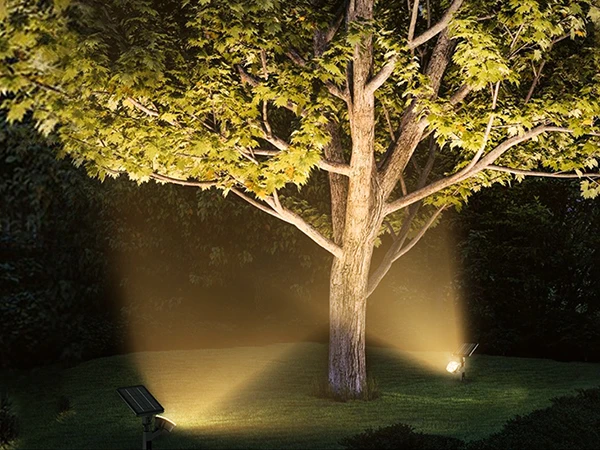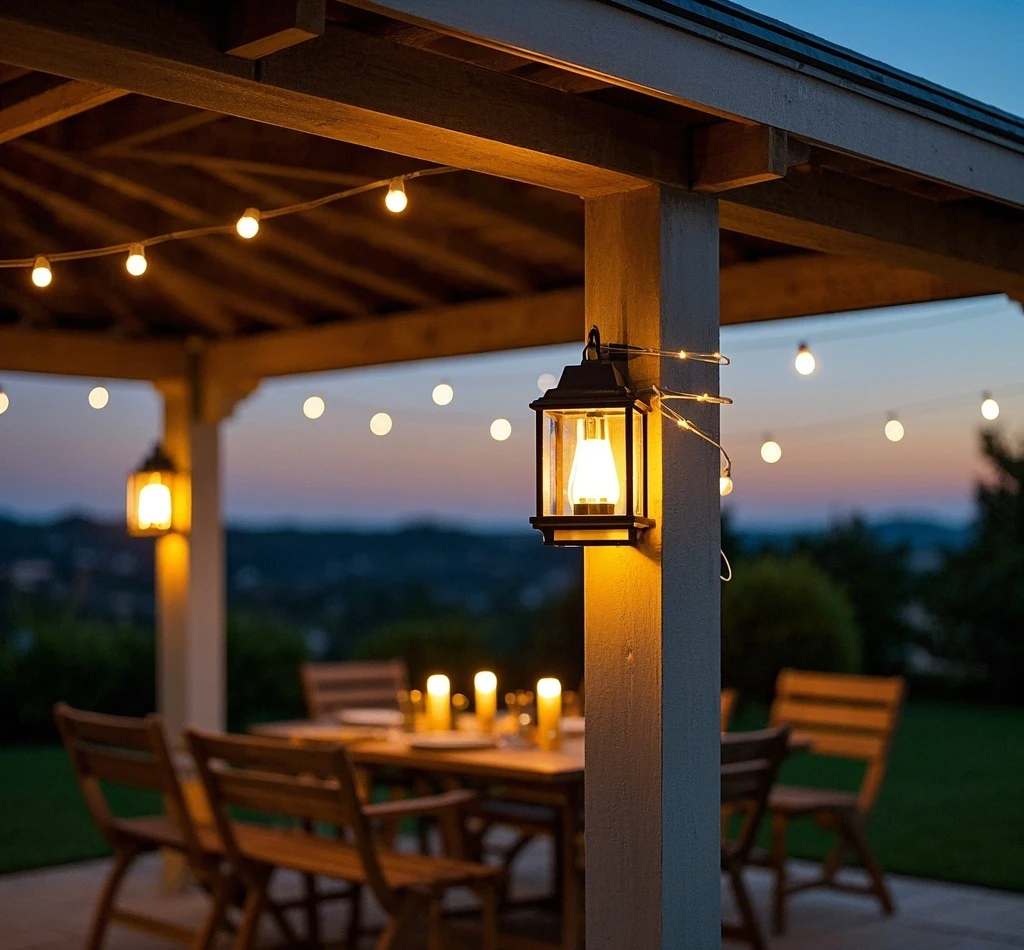Bitpott’s mission is to bring green solar products to households worldwide. This guide aims to help our customers better understand solar garden lights. In this article, we’ll start with the principles of solar lighting. Whether you’re curious about solar panel materials or seeking insights into lighting design, we’ll provide a step-by-step guide. Our structured guide hopes to simplify your purchasing process. Let’s embark on a brilliant journey to explore solar garden lighting together!

How Solar Lights Work
Solar garden lights, as the name suggests, harness the power of the sun to illuminate outdoor spaces, offering a unique experience for outdoor gardeners. These standalone units consist of a solar panel, battery, light source, and sensor. During the day, the solar panel absorbs sunlight, converting it into electrical energy used to generate power. This energy is then stored in the battery. As dusk approaches, the solar panel detects diminishing light, signaling the light source to turn on, and the lamp lights up. The energy stored in the battery powers the light throughout the night, ensuring consistent illumination.
Types of Solar Garden Lights
Depending on the layout of outdoor spaces, solar lights come in various types. Each type serves a unique purpose and meets different functional requirements. A comprehensive understanding of solar garden light types helps businesses make informed purchasing decisions. Common application scenarios include lawns, shrubs, walls, and pathways. Below, we’ll introduce different solar lights based on these four main scenarios.
Classification of Solar Garden Lights
Solar Spotlights
These are ideal for highlighting specific items in a garden, whether it’s a statue, water feature, or a particularly beautiful plant. Apart from solar spotlights, solar lawn lights are also well-known. Their two basic components are a light source and a spike. Installation is simple—just insert them directly into the ground and aim the light source at the area you want to illuminate. These lights focus a beam on a target point, creating a dramatic effect and drawing attention to the chosen area. They typically illuminate walkways, driveways, and garden paths.

Solar Post Lights
Solar post lights offer greater lighting performance than spotlights. Their primary function is to illuminate pathways, and some can also repel mosquitoes. They can be installed on lawns or even on hard surfaces like parking lots or sidewalks, often using metal materials. Accessories for solar post lights typically include a light pole or a base with stakes. Installation is more complex than spotlights, and they are also more expensive.
Solar String Lights
Solar string lights are primarily used for decoration. Their flexibility makes them suitable for more than just shrubs—they can also be used on fences, exterior walls, balconies, and more. Solar string lights are typically made of soft materials like silicone. Available lengths range from 3 meters to tens of meters, catering to different scenario needs. As they are mainly decorative, they offer a wide variety of light color options.
Solar Hanging Garden Lights
Solar hanging garden lights include popular varieties like solar candle lights and solar flame lights. These lights are designed to be hung from trees, patios, or other outdoor structures. They are compact and primarily used to decorate gardens and surrounding areas. These lights often feature different lighting effects, colors, flickering, and other effects. Since the lights require sunlight to charge, care must be taken during installation to ensure that shrub leaves or branches do not block the solar panel.
Solar Wall Lights
Solar wall lights come in two types: one for illumination and another for decoration. Wall lights used for illumination are typically paired with motion sensors. The sensor function enables a more energy-efficient mode, conserving power. Illuminating solar wall lights have larger battery capacities than decorative ones, as lighting requires higher brightness. Decorative solar wall lights have lower brightness requirements and focus solely on aesthetics, offering lighting effects, flickering options, and color choices.

Solar Step Lights
Solar step lights are a functional and decorative lighting solution. Designed for ground-level lighting, they are ideal for stair walls, particularly staircases. As they balance both illumination and decoration, there’s a trade-off between lighting effects and the light itself. Solar step lights come in various color designs but offer fewer effect options. Common materials include stainless steel and plastic, catering to different budgets. They ensure safe nighttime navigation while adding beauty to the surroundings.
Bitpott provides information on various types of solar garden lights, including pathway lights, wall lights, decorative lights, spotlights, and more. This helps you choose the ideal lighting solution based on your unique needs and preferences.
Types of Solar Panels
Solar panels are a critical component for solar lights to generate power. They are responsible for converting sunlight into usable electricity. The cost-effectiveness and advantages of solar panels vary significantly depending on the materials used. Below, we’ll introduce four commonly used solar panel types in the solar lighting market: monocrystalline silicon, polycrystalline silicon, thin-film, and amorphous silicon solar panels.
Types of Solar Panels
Monocrystalline Silicon (Mono-Si)
Monocrystalline silicon solar panels currently offer the highest conversion rates among commercially mass-produced solar panel materials. Due to their higher conversion rates, they are more expensive than polycrystalline silicon panels. Traditional monocrystalline silicon panels have a photoelectric conversion rate of 17% to 22%. However, they charge more slowly in low-light conditions, making them unsuitable for regions with frequent overcast weather. They are typically used for solar lights with illumination needs.
Polycrystalline Silicon (Poly-Si)
Polycrystalline silicon has slightly lower photoelectric conversion efficiency than monocrystalline silicon, with conversion rates ranging from 15% to 17%. Due to lower conversion efficiency, polycrystalline silicon panels require a larger surface area to achieve the same output. Their drawback is slow charging in low-light conditions. They are suitable for all types of solar lights.
Thin-Film Solar Cells (TFSC)
The most direct advantages of thin-film solar panels are their flexibility, lightweight design, and unaffected charging efficiency in low-light conditions. They can be made from various materials, with conversion efficiencies typically ranging from 10% to 13%. Although their photoelectric conversion efficiency is lower, many manufacturers choose them. By factoring in market sunlight duration and strict cost calculations, they are the best choice for regions with insufficient year-round sunlight.
Amorphous Silicon (a-Si)
Amorphous silicon solar panels are also suitable for countries with weaker light conditions, as they can charge efficiently in low light. Their photoelectric conversion efficiency generally ranges from 10% to 15%. The downside is that amorphous silicon’s structure is unstable, and its conversion rate decreases over time, resulting in a shorter lifespan. They are typically used in non-illuminating solar lights, such as decorative or step lights.
For B2B buyers, the choice of solar panel material should align with the intended use of the solar light system, available space, and budget constraints. The conversion rates mentioned above are for reference only. Actual rates depend on the manufacturer’s processes, technology, lamination materials, and other factors. Therefore, we always prioritize the project’s specific needs and real-world product data when making choices.
Battery Choices
The battery largely determines the operating duration of solar garden lights. It stores the energy converted by the solar panel, ensuring stable nighttime illumination even without sunlight. Choosing the right battery optimizes the cost-performance ratio of your solar lights. The most commonly used batteries in solar garden lights are lithium batteries, lithium iron phosphate (LiFePO4) batteries, and nickel-metal hydride (NiMH) batteries.
Types of Garden Light Batteries
Lithium Batteries
Lithium batteries offer high energy density and compact size but are relatively expensive. They are suitable for solar garden lights with illumination needs. Decorative solar lights generally do not use lithium batteries. They have a long lifespan and excellent low-temperature performance, operating at temperatures as low as -30°C. They are used in colder countries like Russia and Canada. Due to the presence of rare earth elements like cobalt, which increase battery activity, a protection board is required, making their cost higher than other batteries.
Lithium Iron Phosphate (LiFePO4) Batteries
LiFePO4 batteries are notable for their long cycle life of up to 2,000 days, offering excellent durability. Their second advantage is high-temperature resistance and fire safety. However, their low-temperature performance is inferior to lithium batteries. They are ideal for markets in tropical regions like Africa or the Middle East. Due to the inclusion of rare earth elements, a protection board is recommended, but their cost is lower than lithium batteries.
Nickel-Metal Hydride (NiMH)
NiMH batteries are the most environmentally friendly option, with no memory effect and a longer lifespan than other nickel-based batteries. However, their overall performance is significantly lower than lithium batteries, with relatively low energy density. Among the three, they are the most economical. They are best suited for small decorative solar lights that don’t require significant power for illumination. NiMH batteries are eco-friendly, containing no active elements, so no protection board is needed during use.
Battery configuration decisions should consider your sales and marketing environment, lifespan, budget, and other factors. The most important aspect of using solar garden lights is the lighting requirement. Buyers need to calculate the battery capacity to ensure several days of illumination. Once capacity is determined, decisions about materials can be made based on safety, cost, and other factors.
Types of Light Chips
Now let’s look at the light chips that make solar garden lights shine. These tiny illuminators determine the brightness, efficiency, and lifespan of the light. For different buyers, chip selection can vary based on specific requirements. This section explores three commonly used chips in garden lights: DIP, SMD, and COB.
Types of Solar Garden Light Chips
DIP (Dual In-line Package) LED
Dual In-line Package (DIP) LEDs are chips housed in a hard plastic bulbous head with two parallel connecting pins. Straw hat LEDs are a common type of DIP LED used in garden lights, with the F10 model being the most widely used. F10 DIP LEDs are known for their compact size and focused light output. Due to their two-pin design, heat dissipation is poor, limiting their lifespan. One notable advantage of F10 LEDs is their ability to produce a focused beam. Their typical luminous efficiency is 80 LM/W, making them suitable for lights with lower brightness requirements. F10 LED production technology is mature, reliable, and relatively low-cost.
SMD (Surface-Mount Device) LED
SMD LEDs are a more modern innovation in garden lighting. Their flat design allows for a more streamlined appearance. SMD LEDs are used in nearly all indoor and outdoor lighting applications. With high thermal resistance and guaranteed heat dissipation, they are far more efficient than F10 LEDs, offering luminous efficiencies of 120–220 LM/W. They are suitable for wall lights, lawn lights, pendant lights, and more. However, SMD LEDs are more expensive than F10 LEDs. Below are some common SMD LED sizes:
| Specification | Size (mm*mm) | Power (W) |
| 2835 | 2.8*3.5 | 0.2W/0.5W |
| 3030 | 3.0*3.0 | 0.5W/1W |
| 5050 | 5.0*5.0 | 1W-5W |
COB (Chip on Board) LED
COB chips offer higher light output density and use fewer components. They can produce high lumens with less energy, achieving at least 120 LM/W. Mounted directly onto the PCB board’s solder pads, they leave more space for heat dissipation. Since multiple chips are encapsulated at once, COB light sources provide more uniform light color, making it easier to control beam angles and design light distribution curves. They are suitable for solar garden lights with specific brightness requirements, such as solar motion-sensor wall lights and solar floodlights.
Understanding Chip Efficiency: Not all chips are equal. A chip’s efficiency is determined by its lumens-per-watt ratio. A higher ratio indicates greater brightness with lower power consumption, extending illumination time and better conserving battery life. Understanding chip characteristics ensures they meet specific market needs. The right chip enhances the performance of solar garden lighting, ultimately ensuring energy efficiency and customer satisfaction.
Motion Sensors
Using solar energy for garden lights promotes sustainability. Another way to improve energy efficiency is by installing motion sensors. These sensors dynamically adjust brightness based on nearby movement. When motion is detected, the light brightens to 100% of its setting. If inactive, it dims to a soft 90% or lower brightness. You can also save energy by adjusting different brightness modes, extending the light’s runtime and reducing energy consumption. This makes garden lighting both eco-friendly and smart.
Aesthetic Design
The aesthetics of solar garden lights play a crucial role in their appeal, and understanding that different buyers have varied tastes is essential. Design isn’t just about appearance—it encompasses functionality, lighting effects, and cultural preferences. For example, European customers often prefer designs echoing vintage European aesthetics, while American customers typically favor simpler, more elegant looks.
Solar Garden Lighting Effect Design
Beyond aesthetics, functionality and visual appeal have become decisive factors in purchasing solar lights. Decorative lights, especially those designed to highlight plants, delve deeper into lighting design than the light itself. Light color, effects, and brightness levels significantly influence a garden’s ambiance.
For solar garden lights required for engineering projects, you should work closely with reputable and experienced suppliers. In essence, the world of solar garden light design is vast, catering to countless tastes and functional needs.
Supplier Evaluation
Choosing the right solar garden light supplier is a decision that goes beyond price points. It’s about ensuring quality, reliability, and a partnership that stands the test of time. Below are several dimensions for evaluating potential suppliers:
Professionalism
First impressions often matter. Gauge a supplier’s professionalism through their communication, responsiveness, and approach to handling inquiries. The process should be transparent, timely, and customer-centric. Established suppliers with years of industry experience have likely faced and overcome challenges, ensuring they can handle complex requirements and unforeseen issues.
Product Development Capability
The solar lighting industry is constantly evolving, and suppliers must stay committed to innovation and market trends. This means investing in cutting-edge technology. Beyond functionality, the design of solar garden lights is critical to their appeal. Suppliers excelling in design deliver efficient, attractive products while catering to diverse customer tastes. This can be assessed by their R&D investment, including the number of engineers, R&D equipment, and designers.
Quality Management
Trustworthy suppliers implement strict quality control to ensure products meet high standards, minimizing defects or performance issues. When communicating with suppliers, ask directly, “Do you have a product management process?” Check whether their quality management standards align with AQL or higher benchmarks.
Certifications
Certifications are seals of approval from industry bodies, verifying that suppliers comply with standards for manufacturing processes, product quality, or safety. Look for suppliers with ISO 9001, BSCI, or other relevant certifications. More experienced manufacturers often have a broader range of certifications.
Choosing a solar garden light supplier is a multifaceted decision. By considering the above factors, buyers can ensure they partner with suppliers who align with their values, quality standards, and design preferences. A strong supplier relationship is the foundation of any successful project or procurement.
Environmental Benefits
Solar garden lights symbolize more than aesthetics or functionality—they represent a sustainable future. Let’s explore these data-backed benefits.
In 2019, IRENA highlighted solar energy’s role in reducing global atmospheric CO2 emissions by 2.5 billion tons. Solar garden lights contribute to this milestone. Recently, a California community case study showed that adopting solar garden lights reduced annual energy usage by 40%, lowering electricity bills and easing grid pressure.
In short, every ray of sunlight illuminates our planet, heralding a greener future. The statistics confirm their significant environmental impact.
Summary
Investing in solar garden lights offers both aesthetic and environmental benefits. From understanding chip types to customizing energy-saving features and designs, buyers have numerous options. Evaluating suppliers based on professionalism, experience, and quality ensures you get the best results. Remember, Bitpott stands out for its commitment to green solutions and customized design practices. Considering bulk purchases? Contact Bitpott today for solar lighting solutions. Help illuminate your garden sustainably! Inquire now!

Comments